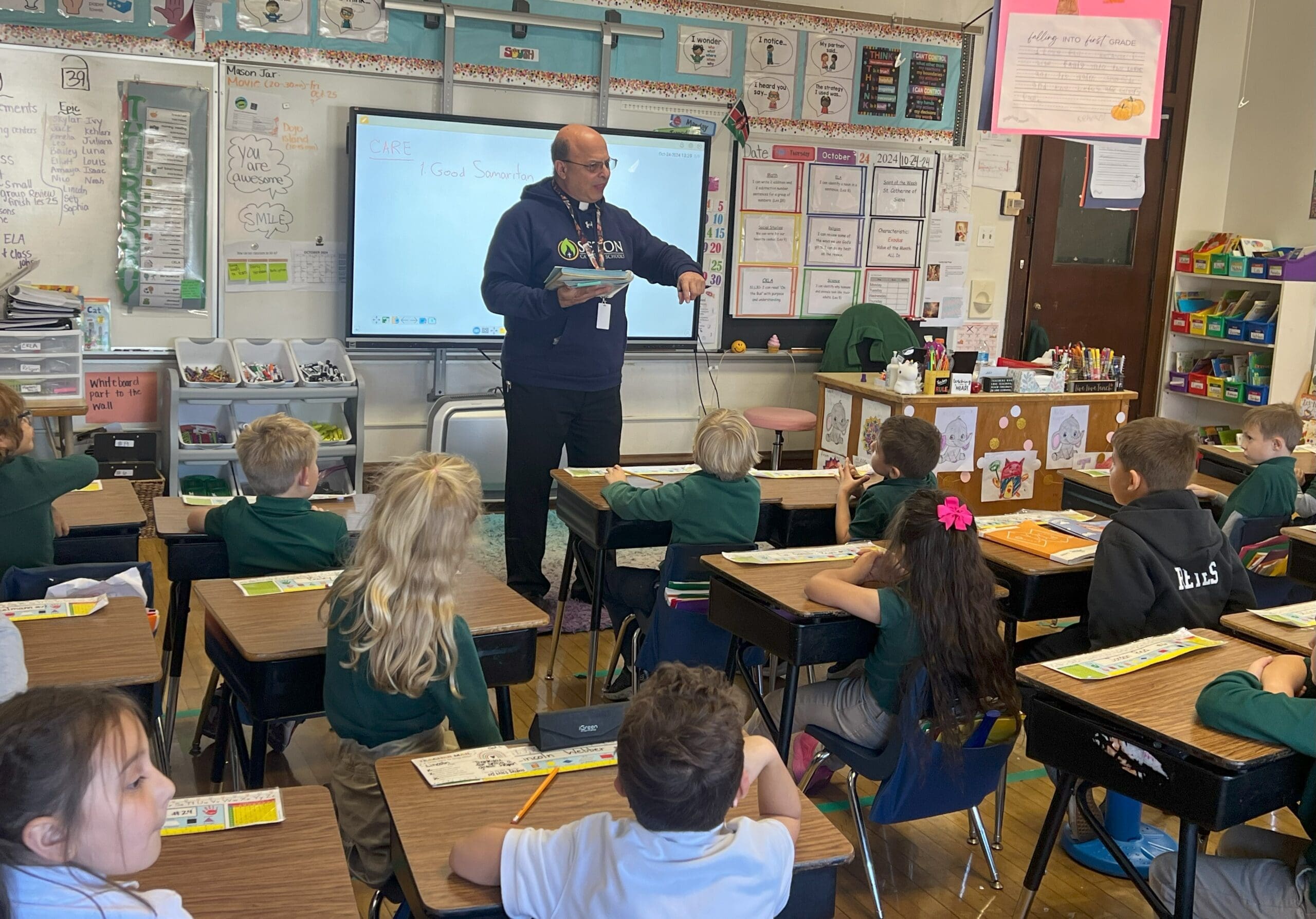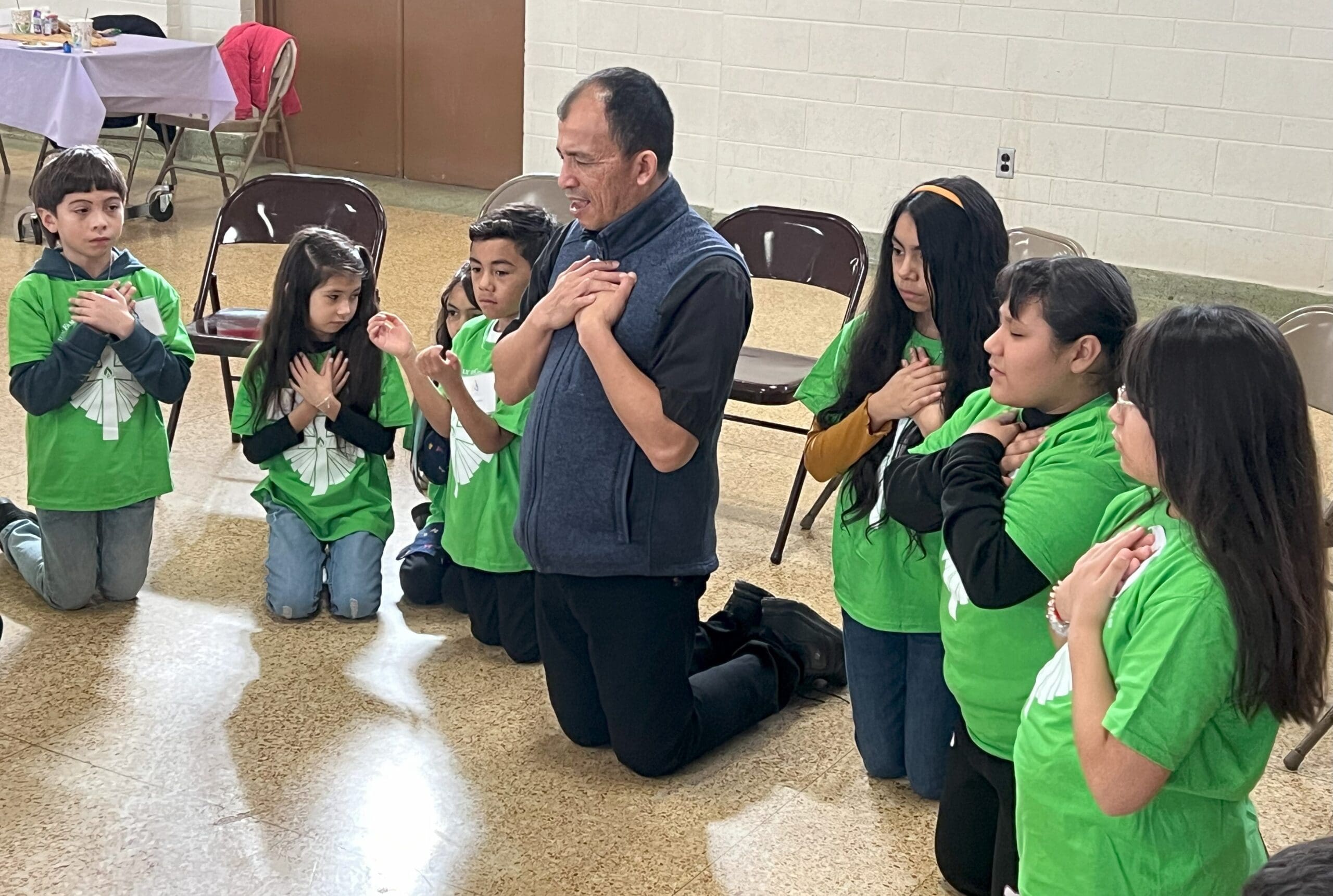
Fr. Carmelo Giuffre teaches religion to the second grade students at St. Thomas Aquinas Academy. Seton Catholic Schools recently received a grant of $1.25 million from Lilly Endowment Inc. to fuel their Faith Immersion Program. (Submitted photo)
JAY SORGI
SPECIAL TO THE CATHOLIC HERALD
Kids these days are constantly feeding themselves with copious content on their electronic devices. It’s often difficult for parents to reach and focus them on getting their homework or chores done, let alone direct their attention and entire being in the direction of Christ.
Seton Catholic Schools, a 14-member grouping of Catholic elementary schools spreading across the city of Milwaukee and into West Allis, is receiving a seven-figure grant to empower its 3,600 students and their families to use technology to help encounter and build a stronger relationship with God.
Lilly Endowment Inc. has given Seton Catholic Schools $1.25 million to fuel their Faith Immersion Program. The gift comes as part of Lilly Endowment’s Nurturing Children Through Worship and Prayer Initiative.
“(The grant is) to really spark children’s connection with God in outside-the-box kinds of ways,” said Seton Catholic Schools Director of Mission and Catholic Identity Jim Schultz.
“What we’re really hoping is to provide a lot of these students, and families as well, opportunities to engage a relationship with God, with Christ, in hopefully generational ways, ways that our parents can access, but also ways that our students can access that are appropriate for the time frame and age that they’re living … easy ways at home and at school to get reconnected with God.”
He said part of the Lilly Endowment grant challenge is to use resources in ways that are faithful to the Catholic tradition, but that represent the culture we live in today.
Schultz said one initiative of their plan involves developing an app that young people can access that includes not just tools for prayer but for podcasts and interactivity with other kids and adult leaders in the faith.
“Prayers, with conversations with a priest, like ‘Ask a priest a question,’ but hearing kids talk to kids,” he said, citing how the popular Halo app involves only adult voices.
“We’re really kind of wanting to investigate how we can get peer-to-peer voices in there so kids can hear other kids talking about God or asking questions about God in their own language, in their own syntax, in their own child-like voice,” Schultz added. “That’s one way we’re really hoping to bridge that technology and age gap when we’re talking about reconnecting with our faith.”
But Schultz said their plans don’t just involve technology, but focused interpersonal encounters with their own family, which normally don’t involve kids at a young age, like multigenerational retreats.
“Going to a retreat with your grandma and your mom and dad, or, if you don’t have a mom and dad, you go with your aunt or your tía in our Hispanic communities,” he said. “It’s different modalities.”
Even more modes of bringing Christ closer in the students’ everyday lives will involve what they see in the hallways, and how counselors and advocates for these youth share more of a Gospel-centered sense of care.
“In our North Side schools, which are predominantly African American, we want to see our African American or African saints up on the wall with a QR code where they can learn more about them just by using their phone,” Schultz said.
“We’re working with the (Boston College) Roche Center for Education and their social and emotional guidance counselor program … that trains our counselors to work with our students through a Gospel lens, so not just counseling them with social emotional needs, but counseling them through those needs through a gospel lens, through an encounter lens with Christ.”
Yet another piece of the Lilly Endowment grant involves fueling their “Contours of Wonder” program, partnering with the McGrath Institute for Church Life at Notre Dame, which uses data and best practices to train educators on infusing worship and prayers into their school lives.
“We have a teacher at every school who’s called a ‘spark.’ They are a teacher who’s designated as a Catholic faith leader in that community,” said Schultz. “(Students) can easily encounter Christ, not only through their curriculum but through the staff members who are being professionally and spiritually developed through these partnerships.”
Ultimately, Schultz’s goal with the grant is to use technology and relationality to catalyze kids into encountering God where they spend their everyday lives, as a part of the school’s mission to “form students as disciples.”
“We need to meet the kids where they’re at in a way that they fall in love with it,” he said.
“Yes, we can fight the phone battle — we can fight the tech battle — but at the end, we’re going to lose, so why not take what they ‘love’ and show them another space where they can fall in love with something that is so beautiful to us, which is our faith?”

